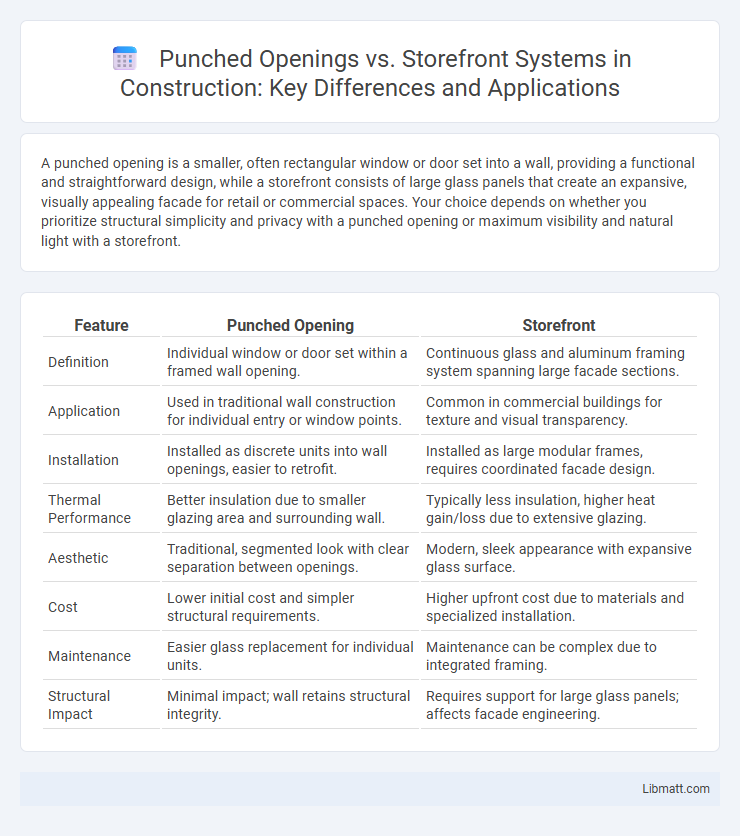A punched opening is a smaller, often rectangular window or door set into a wall, providing a functional and straightforward design, while a storefront consists of large glass panels that create an expansive, visually appealing facade for retail or commercial spaces. Your choice depends on whether you prioritize structural simplicity and privacy with a punched opening or maximum visibility and natural light with a storefront.
Table of Comparison
| Feature | Punched Opening | Storefront |
|---|---|---|
| Definition | Individual window or door set within a framed wall opening. | Continuous glass and aluminum framing system spanning large facade sections. |
| Application | Used in traditional wall construction for individual entry or window points. | Common in commercial buildings for texture and visual transparency. |
| Installation | Installed as discrete units into wall openings, easier to retrofit. | Installed as large modular frames, requires coordinated facade design. |
| Thermal Performance | Better insulation due to smaller glazing area and surrounding wall. | Typically less insulation, higher heat gain/loss due to extensive glazing. |
| Aesthetic | Traditional, segmented look with clear separation between openings. | Modern, sleek appearance with expansive glass surface. |
| Cost | Lower initial cost and simpler structural requirements. | Higher upfront cost due to materials and specialized installation. |
| Maintenance | Easier glass replacement for individual units. | Maintenance can be complex due to integrated framing. |
| Structural Impact | Minimal impact; wall retains structural integrity. | Requires support for large glass panels; affects facade engineering. |
Introduction to Punched Openings and Storefronts
Punched openings are individual window or door units set into a solid wall, characterized by their discrete, framed appearance that offers controlled views and enhanced structural support. Storefronts consist of large, continuous glass panels integrated into commercial facades, designed to maximize visibility and natural light while providing easy access for customers. Your choice between punched openings and storefronts impacts building aesthetics, energy efficiency, and interior ambiance.
Defining Punched Openings
Punched openings are wall penetrations featuring individual, framed windows or doors that are set directly into the building facade, providing distinct and isolated entrances or views. Unlike storefront systems which emphasize continuous glass panels spanning large sections, punched openings create a more segmented architectural appearance often used for thermal efficiency and privacy. Your choice between punched openings and storefront designs will impact both the building's aesthetics and functional performance.
Understanding Storefront Systems
Storefront systems feature large glass panels framed by aluminum, creating expansive, aesthetically pleasing entrances that enhance natural light and visibility. Punched openings are more traditional, consisting of individual windows or doors set into solid walls, offering better structural strength and energy efficiency. Understanding storefront systems allows you to choose designs that maximize natural light and modern appeal while balancing security and insulation needs.
Key Differences Between Punched Opening and Storefront
Punched openings are individual window or door units set into the wall with distinct frames, offering limited glazing area and enhanced structural support, typically used in residential or traditional buildings. Storefront systems feature large expanses of glass framed with aluminum, allowing maximum light penetration and visibility, commonly employed in commercial and retail environments. The key differences lie in their scale, design intent, and application, with punched openings providing compartmentalized fenestration and storefronts emphasizing transparency and openness.
Architectural Applications
Punched openings, characterized by individual window or door units set into a solid wall, are ideal for traditional architectural applications requiring structural clarity and rhythm. Storefront systems, consisting of large glass panels framed in aluminum or steel, are preferred in commercial designs where maximizing visibility and daylight is essential. Your choice depends on balancing aesthetic goals with functional requirements such as natural light, energy efficiency, and facade articulation.
Aesthetic Considerations
Punched openings offer a traditional, minimalistic aesthetic with clearly defined frames that emphasize solidity and rhythm on a building's facade, making them ideal for modular architectural designs. Storefront systems provide sleek, expansive glass surfaces that maximize natural light and visibility, creating a modern, transparent look suited for commercial spaces. The choice between punched openings and storefronts significantly impacts the building's visual identity, balancing between classic articulation and contemporary openness.
Energy Efficiency and Performance
Punched openings, characterized by smaller window and door inserts within thick walls, generally offer higher energy efficiency due to reduced heat transfer and better insulation compared to larger storefront systems. Storefronts, with extensive glass panels, provide more natural light but often require advanced glazing and thermal breaks to improve performance and minimize energy loss. Your choice between punched openings and storefronts should balance aesthetic preferences with specific energy performance goals for optimal building efficiency.
Installation and Maintenance
Punched openings offer simpler installation due to their pre-framed structure, reducing labor time compared to the larger, more complex storefront systems that require precise alignment of multiple glass panels. Maintenance of punched openings is typically easier and less costly, as their smaller size limits exposure to weather elements and reduces the risk of seal failure. Your choice between these two should consider the ease of installation and long-term upkeep based on the project's scope and budget.
Cost Comparison
Punched openings typically cost less than storefront systems due to simpler installation and smaller glass panels, reducing material and labor expenses. Storefronts, featuring larger glass areas and custom framing, involve higher upfront costs but offer better aesthetic appeal and natural lighting. Your choice depends on balancing budget constraints with desired design impact and energy efficiency.
Choosing the Right Solution for Your Project
Punched openings provide a more traditional and energy-efficient option, ideal for projects requiring enhanced thermal performance and structural integrity. Storefront systems offer larger glass areas and modern aesthetics, perfect for commercial spaces aiming to maximize natural light and visibility. Evaluating factors such as budget, building code requirements, and design goals ensures selecting the optimal solution for your construction project.
Punched opening vs Storefront Infographic

 libmatt.com
libmatt.com